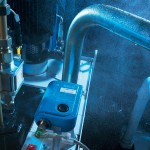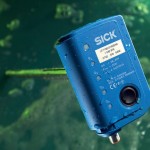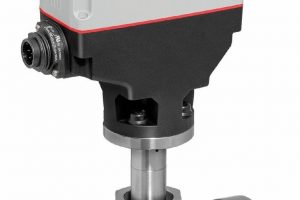The LFT filling level measurement system from Sick offers versatile use and parameterisation. It unites continuous level measurement and limit detection in a single device. What is special here is the LFT’s sensor principle: time-domain reflectometry. In combination with a coaxial probe, these guided microwaves make the filling level measurement system independent of influences resulting from installation, the container or the medium, whereby the device is suitable for almost all water and oil-based liquids.
Xaver Meier, Christoph Müller
The LFT is typically used on containers and tanks in the water industry, in mechanical engineering, on machine tools, in plant construction and in building services systems. Here, the almost completely friction- and maintenance-free device demonstrates its high precision and sturdiness with the most varied of filling media, e. g. coolants, abrasive and hydraulic oils, degreasers and detergents, among others.
The LFT’s measurement principle is based on so-called time-domain reflectometry (TDR). This is a process for determining and analysing the run lengths and reflective characteristics of electromagnetic waves and signals.
TDR provides independence from application environment
The LFT consists of an electronic and evaluation unit in an IP 67 housing with an operating element and a variety of interfaces for signal output, as well as a highly resistant coaxial measurement probe made of 1.4404 stainless steel. The electronics generate high-frequency, low-energy microwave pulses, concentrated in the probe and passed along it. These pulses are reflected wherever they meet the surface of the liquid to be detected, and then run back along the probe to the electronics. The device determines the current filling level by the time difference between the emitted and the received pulse – with an accuracy of a few millimetres. The LFT’s TDR process and the coaxial design of its probe offer a variety of advantages in practical filling level measurement. The measurement results are – unlike the effective principles of some other sensors – only insignificantly affected by the properties of the medium to be measured. This also applies for the dielectric constant «r. The LFT measures even oil with a typical «r of 1.8, while comparable systems are often unsuitable for the measurement of oil or oil-based liquids. Moreover, the LFT requires no reconfiguration when the physical properties of the liquid change. Regardless of the medium to be detected, the system achieves a measurement accuracy of 3 mm within its measurement range of between 30 and 1990 mm. The LFT thus attains a measurement and switching accuracy that is otherwise only offered by considerably more complicated filling level measurement systems.
Because there is always a defined, interference-free environment within the measurement probe, the LFT also offers a high level of freedom regarding the container properties and installation location. It can be used in both stainless steel tanks and plastic containers. For this purpose, the LFT offers a choice of G¾ A or ¾” NPT connection threads – there is thus no need for a connection flange.
Simple operation
Geometry and shape have no effect on the measurement principle because there is no interplay with the container wall, but only within the probe. For this reason, even heavy surface movements, such as would be caused by a container inlet or stirring equipment, have no effect on level detection. Finally, the TDR process also operates independently of factors such as pressure and temperature. The LFT combines continuous filling level measurement, limit value detection and overfill protection functions in a single device. It offers easy operation regardless of the concrete task involved. The switching points are set via a single teach-in button, the switching outputs are switched between an N.O. contact and N.C. contact, the hysteresis levels for the switching outputs are set, and the actual measurement range along the coaxial probe is defined. In addition to a 4…20 mA analogue output, the LFT also has four switching outputs which can each be independently programmed. Thus, the more switching points require determination, the more economical is the LFT compared to the use of separate limit value switches. Two switching points can be linked together, if a min./max. control is required, e. g. for controlling a pump between a minimum and maximum level. Finally, the LFT offers high availability thanks to the TDR technology. The device has no moving parts and thus no parts that are potentially subject to failure. The probe is constructed in such a way that any internal product adhesion is prevented. The LFT is correspondingly almost completely friction- and maintenance-free.
Filling level measurement technology for all cases
With the LFT, Sick has supplemented its range of products for filling level measurement systems for the most varied of media. Solutions based on differing operating principles are available for continuous measurement as well as for limit level detection for liquids, bulk materials and sediments – from radar, ultrasound and guided microwaves, through laser with time-of-flight measurement of pulses or light, to capacitive sensors and rotating wing systems. As numerous applications require more than just a standard device, solutions with Atex approval, designed for high temperatures of up to 800 °C, or suitable for container pressures of up to 40 bar are also available.
Hall 9, Booth F54
cpp 425
Mehr zum LFT-Füllstandsensor
Informationen zur Zeitbereichsreflektometrie
Share:








